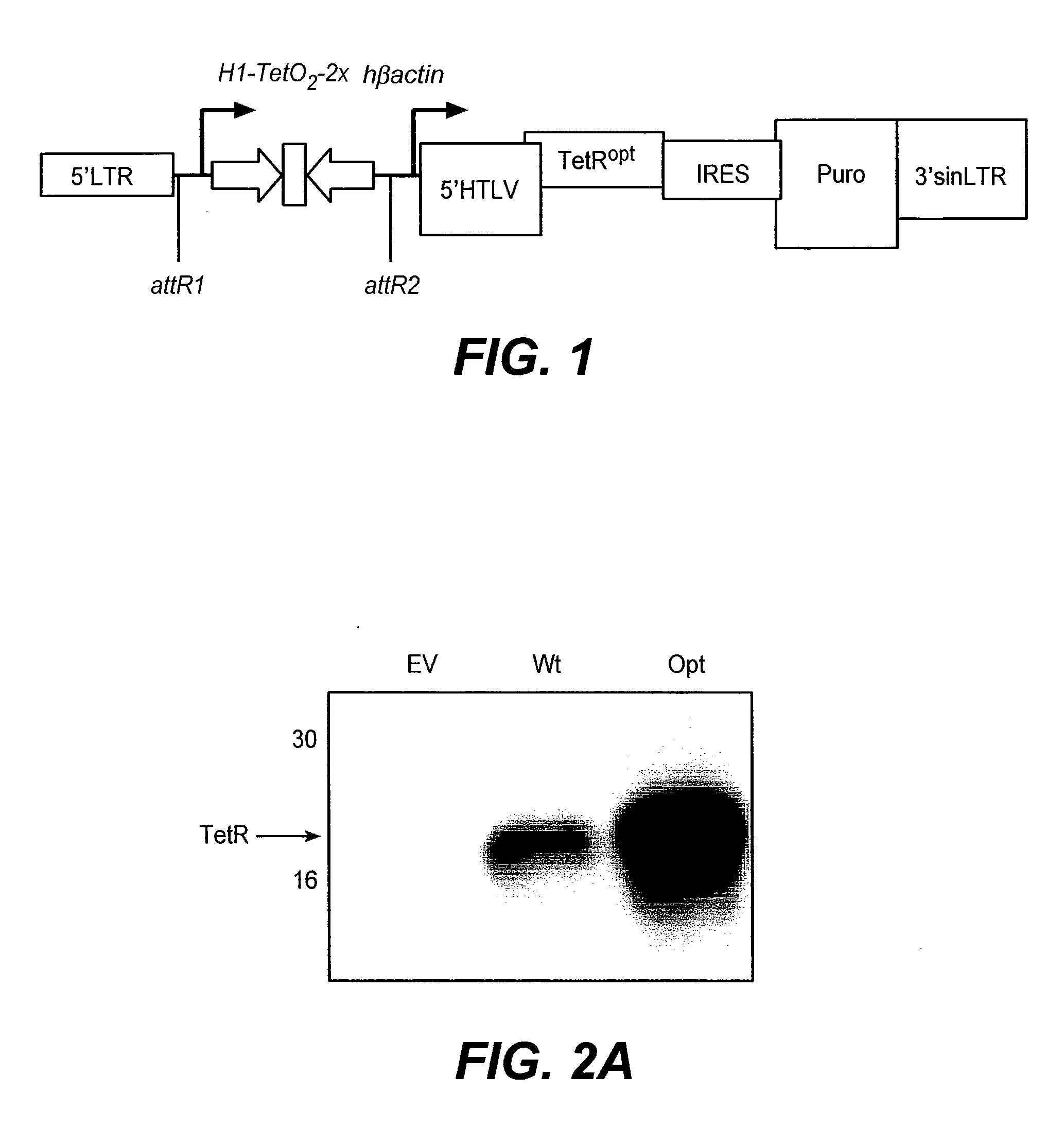Vectors and Methods Using Same
a vector and method technology, applied in the field of vectors and methods using same, can solve the problems of hampered mammalian genetic studies, lack of efficiency in efficiently generating stable loss-of-function phenotypes, and rna interference methods, etc., to achieve the effect of suppressing, reducing, or “knocking down” expression
- Summary
- Abstract
- Description
- Claims
- Application Information
AI Technical Summary
Benefits of technology
Problems solved by technology
Method used
Image
Examples
example 1
Inducible Vector for Expression of RNA Coding Regions
[0436]To generate a vector suitable for tetracycline-inducible expression of RNA coding regions, we incorporated a modified polIII promoter (a H1 promoter comprising a one or more tetR operon (Tet-O) sites) into a single retroviral expression plasmid to direct conditional expression of RNA coding regions in cells of choice. In the off state, the Tet repressor protein (TetR) binds the modified polIII promoter, thereby preventing siRNA expression. However, in the presence of a tetracycline analog, doxycycline (Dox), the Tet repressor protein is released from the promoter, permitting siRNA transcription. Using retroviral delivery, followed by selection for puromycin resistance, cell clones with stable integration of this RNA coding region-expression cassette can be rapidly generated.
[0437]In one embodiment, our vector system is comprised of a kanamycin-resistant, H1 promoter-driven shRNA expression shuttle plasmid and an ampicillin-r...
example 2
Optimization of the Inducible RNA Coding Region Expression Vector
[0440]Performance of the inducible vector was optimized by codon optimizing the TetR sequence for mammalian expression. The performance of the vector was further optimized by incorporating a modified polIII promoter comprising two TetO binding sites. These elements were included in several of the retroviral vectors described in the remainder of the Examples, except as otherwise indicated below.
[0441]Codon Optimized TetR Significantly Increased Repression of shRNA Expression
[0442]The TetR coding region was codon optimized for mammalian expression using the DNAWorks program (available from the NIH, Bethesda Md.). The polynucleotide and amino acid sequences of the codon-optimized TetR is shown in SEQ ID NO:1 and SEQ ID NO:2, respectively. Using a compatible end derived from a BsaI site, we ligated the codon optimized TetR in-frame to the NcoI start site of pDRIVE-5′RU (Invitrogen, San Diego, Calif.). The human β-actin Tet...
example 3
Dose-Response of Dox-Induced Gene Knock-Down In Vitro and In Vivo
[0452]To determine whether Dox dose correlated with the level of inhibition of target gene expression, we performed dose-response experiments in which the level of Dox was varied, using in vitro and in vivo models.
[0453]First, we examined the regulated shRNA-mediated depletion of luciferase gene expression using luciferase-expressing SVT2 cells in vitro. Briefly, cells were infected with a pHUSH inducible retroviral vector comprising the following shRNA targeting the luciferase coding region:
shLUC-GL3(SEQ ID NO: 9)5′-GAT CCC CCT TAC GCT GAG TAC TTC GAT TCA AGA GATCGA AGT ACT CAG CGT AAG TTT TTT GGA AA-3′.
Cells were selected with puromycin and individual clones with Dox regulated luciferase expression identified (referred to as SVT2_GL3_pHUSH shLUC). Cells were cultured for 2 days (diamonds), 4 days (squares) or 7 days (triangles) at the indicated dose of doxycycline (see FIG. 4) and then assayed for luciferase activity...
PUM
| Property | Measurement | Unit |
|---|---|---|
| length | aaaaa | aaaaa |
| compositions | aaaaa | aaaaa |
| binding structures | aaaaa | aaaaa |
Abstract
Description
Claims
Application Information
 Login to View More
Login to View More - R&D
- Intellectual Property
- Life Sciences
- Materials
- Tech Scout
- Unparalleled Data Quality
- Higher Quality Content
- 60% Fewer Hallucinations
Browse by: Latest US Patents, China's latest patents, Technical Efficacy Thesaurus, Application Domain, Technology Topic, Popular Technical Reports.
© 2025 PatSnap. All rights reserved.Legal|Privacy policy|Modern Slavery Act Transparency Statement|Sitemap|About US| Contact US: help@patsnap.com



